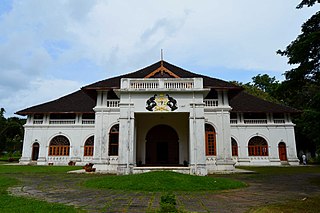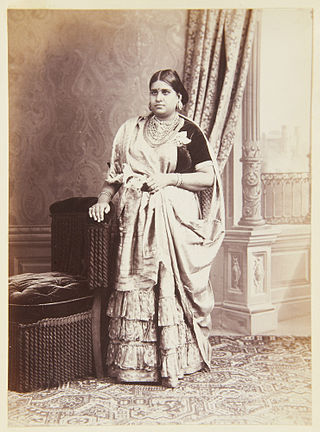
The Kingdom of Cochin, named after its capital in the city of Kochi (Cochin), was a kingdom in the central part of present-day Kerala state. It commenced at the early part of the 12th century and continued to rule until 1949, when monarchy was abolished by the dominion of India.
Ayyanthole is an administrative and residential area situated in the City of Thrissur, Kerala, India. Ayyanthole is the 53rd Ward of Thrissur Municipal Corporation. Ayyanthole is the administrative center for the Thrissur District. Ayyanthole houses the various state governmental offices, as well as the District and Sessions Courts.

Kerala Varma Valiya Koil Thampuran also spelt Kerala Varma Valiya Koilthampuran and known as Kerala Varma, was a Malayalam - language poet and translator who had an equal facility in writing in English and Sanskrit from the Indian state of Kerala. He was part of the royal family of erstwhile Parappanad, Malappuram district. Kerala Varma is also known as the Kalidasa of Kerala.

Rama Varma Kunji pillai Thampuran (1751–1805), or Rama Varma IX, popularly known as Sakthan Thampuran, was the ruler of the Kingdom of Cochin. The current southern Indian city of Kochi was part of the erstwhile princely state of Kochi. He resided at Vadakkechira Palace in Thrissur. The city of Thrissur is referred to as the Cultural Capital of Kerala owing to its many traditional festivals and historic temples. Sakthan Thampuran is considered the architect of the city of Thrissur. The festival Thrissur Pooram was started by him.

Pandit Karuppan was a poet, dramatist, and social reformer who lived in Kerala, India.

Kochi is a city located in the Ernakulam District in the Indian state of Kerala located about 200 km from Trivandrum, the capital of Kerala.

Kilimanoor Palace is a palace located in Kilimanoor, in the Indian state of Kerala. It is the birthplace of painter Raja Ravi Varma and Raghava Varma, the father of king Marthanda Varma.

Shakthan Thampuran Palace is situated in City of Thrissur in Kerala state, India. It is named as Vadakkekara Palace, was reconstructed in Kerala-Dutch style in 1795 by Ramavarma Thampuran of the erstwhile Princely State of Cochin, well as Sakthan Thampuran is preserved by Archaeological Department. The palace was converted into a museum in 2005 by State.

Thrissur is the administrative capital of Thrissur District, in the central part of Kerala state, India. Thrissur district was formed on 1 July 1949. It is an important cultural centre, and is known as the Cultural Capital of Kerala. It is famous for the Thrissur Pooram festival, one of the most colourful and spectacular temple festival of Kerala. From ancient times, Thrissur has been politically, economically and culturally significant to the Indian subcontinent. It has opened the gates for Arabs, Romans, Portuguese, Dutch and English. According to tradition, Thrissur is where Christianity, Islam and Judaism entered the Indian subcontinent. Local Christian tradition holds that Thomas the Apostle arrived in 52 CE, and Muslim tradition states that Methala is the location of country's first mosque.
The name Kerala Varma may refer to many people from many royal families from the Indian state of Kerala.
Maharaja Gangadahra Koviladhikarikal Sri Ravi Varma (1865–1946) was the Maharaja of Cochin, India in 1943–46.

Parappanangadi, IPA: [pɐɾɐpːɐn̺ɐŋːɐːɖi], is a major town and a municipality in Tirurangadi taluk of Malappuram district, Kerala, India. It is a coastal town located close to the Arabian sea. Parappanangadi railway station is one of the oldest railway stations in Kerala. It was a part of the first rail route (Tirur–Chaliyam) in Kerala. Parappanangadi is located 9 km (5.6 mi) north of Tanur on Tirur-Kadalundi Tipu Sultan Road. The town lies on the bank of Kadalundi River. Parappanangadi town is located north of the estuary of Poorappuzha River, which is a tributary of Kadalundi River, and south of the estuary of Kadalundi River, which lies in Vallikkunnu. Parappanangadi was one of the major ports in the southwestern coast of India during the medieval period. It was ruled by the kingdom of Parappanad, who were vassals to the Zamorin of Calicut, and had the jurisdiction up to Beypore port to the north. In the early medieval period, under the chiefs of Kozhikode and Parappanangadi, Parappanangadi developed as one of the important maritime trade centre on the Malabar Coast. Later it became a part of Eranad Taluk in Malabar District under British Raj.

The Travancore royal family was the ruling house of the Kingdom of Travancore. They gave up their ruling rights in 1949 when Travancore merged with India and their political pension privileges were abolished in 1971. The family is descended from the Ay/Venad family and the Chera dynasty.

Kerala Varma, most commonly known as Mahakavi Pandalam Kerala Varma, was an Indian poet, scholar, and publisher. He was born in Pandalam, and belonged to the Pandalam Royal Family. He wrote two mahakavyas, more than a hundred narrative poems, translations, and children's poetry. He is widely regarded as the author of the first complete mahakavya in Malayalam. He was the owner and Chief Editor of Kavana Kaumudi, the first Malayalam periodical, which was also the first to introduce special issues in Malayalam.

Kerala Varma Thampuran popularly known as Aikya Keralam Thampuran or Kerala Varma VII was the Maharaja (king) of Cochin who ruled between 1946 and 1949. He mooted the idea of a unified Kerala state in India for the Malayalam speaking population and stood for the merging of British Malabar, Cochin and Travancore. Therefore, he was given the sobriquet Ikyakeralam Thampuran. He died in July 1948. He was also the brain behind the formation of Sree Kerala Varma College at Thrissur, named after him.

Maharani Bharani Thirunal Lakshmi Bayi CI (1848–1901) was the Senior Rani of Travancore from 1857 till her death in 1901. Her consort was the famous poet and writer, styled the father of Malayalam literature, Sri Kerala Varma Valiya Koil Thampuran.
Parappanad was a former feudal city-state in Malabar, India. The headquarters of Parappanad Royal family was at the town Parappanangadi in present-day Malappuram district. In 1425, the country divided into Northern Parappanad and Southern Parappanad. Southern Parappanad included parts of Tirurangadi Taluk and the town Parappanangadi. Northern Parappanad included Panniyankara, Beypore, and Cheruvannur of Kozhikkode Taluk. Parappanad royal family is a cousin dynasty of the Travancore royal family.

Koyi Thampuran was the title of the Prince Consorts of the Queens and Princesses of Travancore. The Koyi Thampurans' gained prominence and prestige in Kingdom of Travancore as they were the fathers of the then reigning Kings. In Travancore, there were ten clans of Koyi Thampurans. The most ancient were the ones settled at Kilimanoor ; others were Kirthipuram, Pallam, Paliyakkara and Nirazhi, Ananthapuram, Chemprol, Cherukol, Karazhma and Vatakkemadham.

Lakshmipuram Palace is the royal palace of the Parappanad royal families at Changanassery. Palace is located at Puzhavathu near to Kavil Bhagavathy Temple. The Lakshmipuram Palace was built in 1811 AD by Travancore ruler Maharani Ayilyom Thirunal Gouri Lakshmi Bayi (1791–1815) on behalf of the family of her husband Raja Raja Varma Valiya Koil Thampuran. Until then, the royal family at the Neerazhi Palace in Changanacherry had been moved to newly built Lakshmipuram Palace. It was the seat of the royal family of Koi thampurans and has produced many illustrious writers such as Raja Raja Varma Koil Thampuran, Kerala Varma Valiya Koil Thampuran and A. R. Raja Raja Varma. Noted Malayalam singer and classical musician L. P. R. Varma also hails from this palace.

Aikya Kerala Movement, the movement to establish a united Kerala was one of the political movements in present-day Kerala state of India. The term Aikya Kerala literally means 'United Kerala'. It has been a statewide peaceful movement for a united Kerala state for all Malayalam speaking people, which lasted for more than three decades. Following the movement, The Malayalam-speaking regions of the Travancore–Cochin merged with the Malabar District and the Kasaragod Taluk of South Canara district in Madras State to form the modern Kerala state on 1 November 1956, according to the States Reorganisation Act, 1956 passed by the Government of India.















